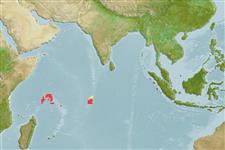>
Eupercaria/misc (Various families in series Eupercaria) >
Lethrinidae (Emperors or scavengers) > Lethrininae
Etymology: Lethrinus: Greek, lethrinia, a fish pertaining to genus Pagellus.
More on author: Smith.
Environment: milieu / climate zone / depth range / distribution range
экология
морской ассоциированный с рифами; немигрирующий; пределы глубины ? - 50 m. Tropical; 3°S - 9°S
Western Indian Ocean: known only from the Seychelles. Has been synonymized with Lethrinus mahsena.
Length at first maturity / Size / Вес / Возраст
Maturity: Lm 25.0 range ? - ? cm
Max length : 55.0 cm TL самец/пол неопределен; (Ref. 2295); common length : 32.5 cm TL самец/пол неопределен; (Ref. 2295)
колючие лучи спинного плавника (общее число): 10; членистые (мягкие) лучи спинного плавника (общее число): 9; колючие лучи анального плавника 3; членистые (мягкие) лучи анального плавника: 8. Body is yellowish bronze or gray, becoming lighter ventrally. Sometimes three bronze stripes are on the upper side. The head is gray, brown or sometimes bronze with a series of yellowish cross stripes on the upper portion of the head and snout. A light streak radiates from the eye to the anterior nostril. the lower edge of the orbit has dark purplish spots. The maxilla is reddish. The fins are pale, yellowish or bronze.
Found over seagrass beds, coral reefs and adjacent sandy areas. Feeds mainly on echinoderms, crustaceans, and fish, and to a lesser degree on mollusks. Smaller, more numerous females than males have been confirmed for the Saya de Malta population (Ref. 2295). Marketed fresh (Ref. 171).
Life cycle and mating behavior
половая зрелость | размножение | нерест | икра | Fecundity | личинки
Carpenter, K.E. and G.R. Allen, 1989. FAO Species Catalogue. Vol. 9. Emperor fishes and large-eye breams of the world (family Lethrinidae). An annotated and illustrated catalogue of lethrinid species known to date. FAO Fish. Synop. 125(9):118 p. Rome: FAO. (Ref. 2295)
Статус Красного Списка МСОП (Ref. 130435)
Угроза для людей
Harmless
Использование человеком
рыболовство: коммерческий
дополнительная информация
ссылкиаквакультура (рыбоводство)особенности рыбоводствастепень растяжениягенетикаElectrophoresesнаследуемостьболезниобработкаNutrientsMass conversion
соавторыизображенияStamps, Coins Misc.звукиCiguateraскоростьтип плаванияжаберная областьOtolithsмозгзрение
инструменты
Специальные отчеты
Скачать в формате XML
ресурсы в Интернет
Estimates based on models
Preferred temperature (Ref.
123201): 25.8 - 28.2, mean 27.6 °C (based on 10 cells).
Phylogenetic diversity index (Ref.
82804): PD
50 = 0.5000 [Uniqueness, from 0.5 = low to 2.0 = high].
Bayesian length-weight: a=0.01479 (0.00742 - 0.02950), b=2.99 (2.83 - 3.15), in cm total length, based on LWR estimates for this species & Genus-body shape (Ref.
93245).
Trophic level (Ref.
69278): 3.8 ±0.58 se; based on food items.
устойчивость к внешним воздействиям (Ref.
120179): низкий, минимальное время удвоения популяции 4.5-14 лет (K=0.13-0.18).
Fishing Vulnerability (Ref.
59153): Moderate to high vulnerability (54 of 100).
Nutrients (Ref.
124155): Calcium = 36.1 [26.0, 48.7] mg/100g; Iron = 0.737 [0.501, 1.016] mg/100g; Protein = 20.1 [17.5, 22.3] %; Omega3 = 0.122 [0.090, 0.163] g/100g; Selenium = 41 [21, 60] μg/100g; VitaminA = 36.5 [7.9, 195.4] μg/100g; Zinc = 2.12 [1.66, 2.64] mg/100g (wet weight); based on
nutrient studies.
